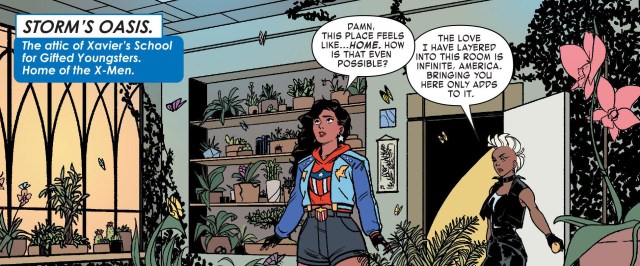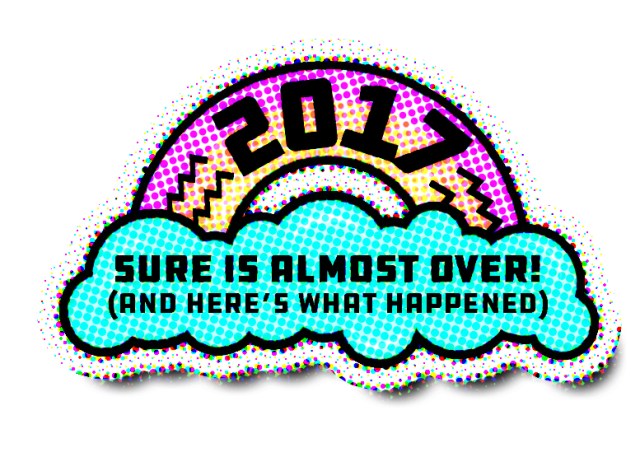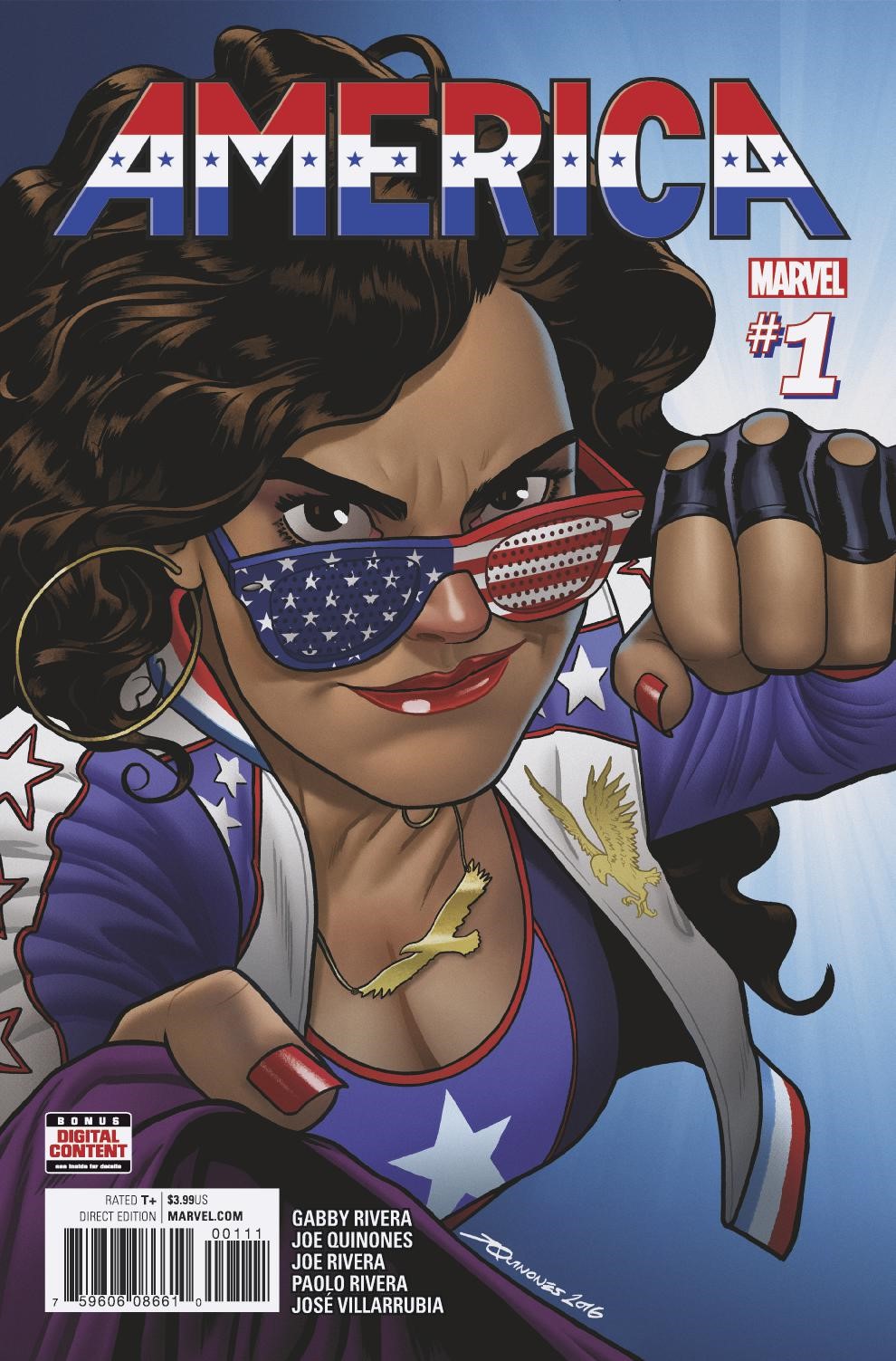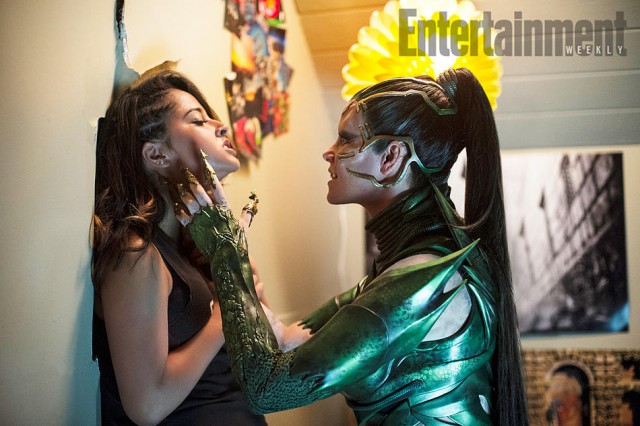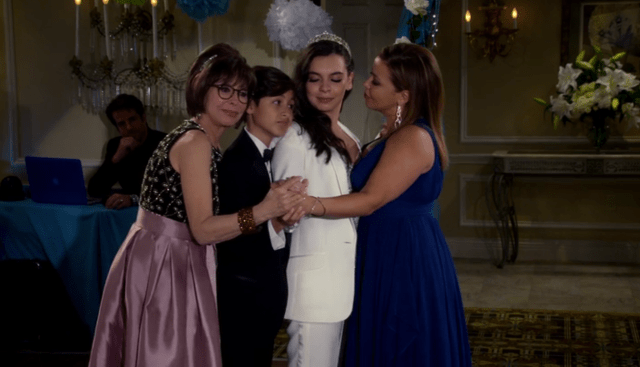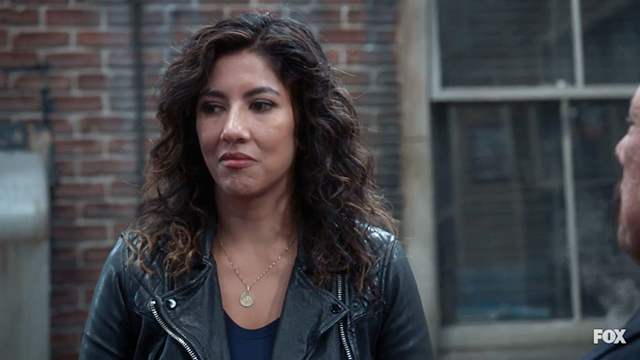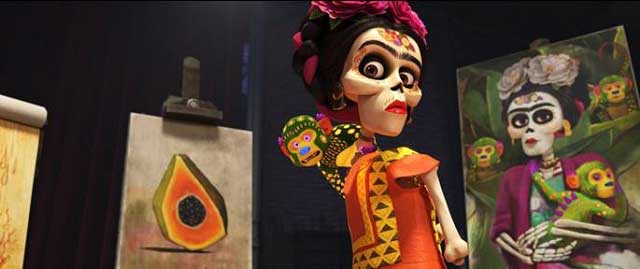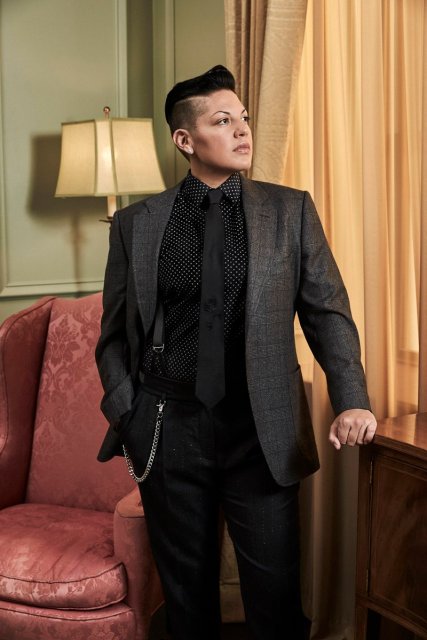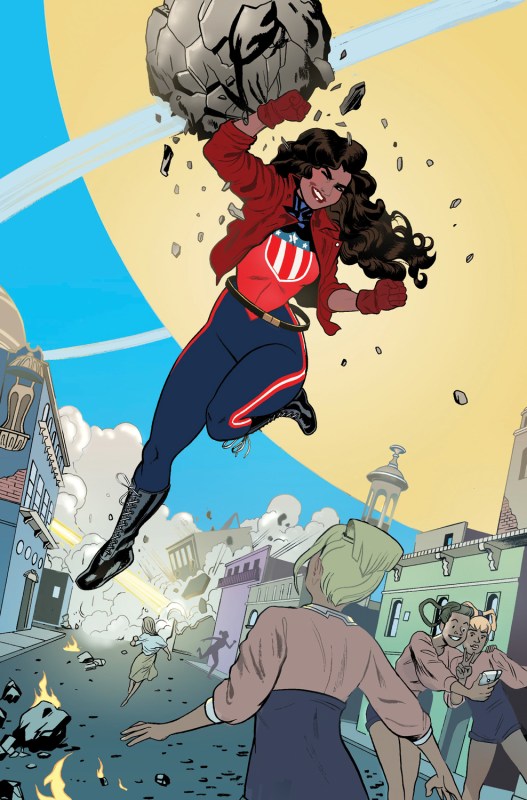Drawn to Comics: America Vol 1: “The Life and Times of America Chavez” Punches You In the Face (In a Good Way)
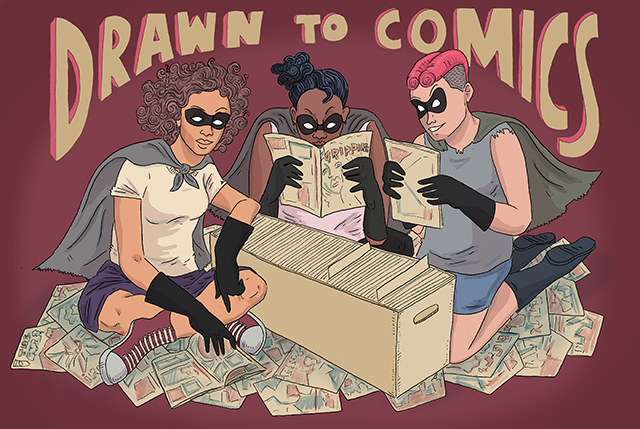
by rory midhani
I first met America Chavez in Young Avengers, and it changed my entire view of comics. I had never seen a character that was so much like me and such a badass. The first time I read an America Chavez comic, written by former Autostraddle writer Gabby Rivera, it changed everything all over again. This time I wasn’t just seeing a generic Latina badass superhero, I was seeing one who talked like me and has a family who looks like me and seems like an actual real life Latina. In the first trade paperback of America Chavez’s solo series, The Life and Times of America Chavez, Rivera takes the seed of a character who was already one of the best parts of the Marvel Universe and fully fleshes her out.
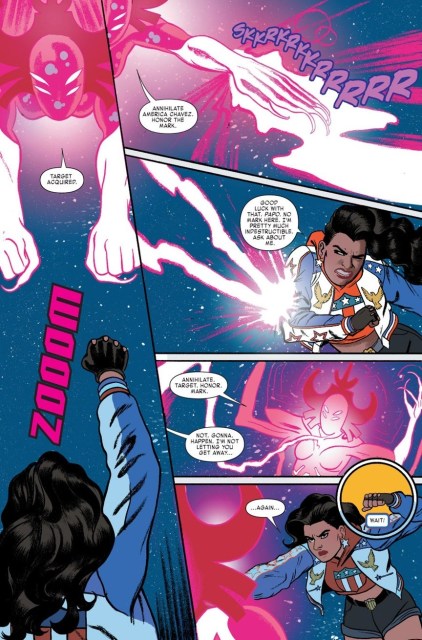 This first trade collects America 1-6, and shows our favorite girl heading off to college at Sotomayor University. It’s where her powers start expanding, her girlfriend gets kidnapped by teenage aliens who have an America Chavez based cult, and she starts to learn how to be a better hero. She’s been so used to just punching all her problems; here she gets to learn from other great female heroes like Peggy Carter and Storm about how to be a better version of herself. It’s a great example of women helping women. She goes on a roadtrip with her bff/potential wifey Kate Bishop Hawkeye just in time to finish the women-supporting-women story arc. For all you shippers out there, there’s even a part where America goes flying off with a former fling and Kate is left behind waxing poetic about how great dating women looks and how she’ll be jealous if America and this other girl get married. Seriously. Kate. You’re gay.
This first trade collects America 1-6, and shows our favorite girl heading off to college at Sotomayor University. It’s where her powers start expanding, her girlfriend gets kidnapped by teenage aliens who have an America Chavez based cult, and she starts to learn how to be a better hero. She’s been so used to just punching all her problems; here she gets to learn from other great female heroes like Peggy Carter and Storm about how to be a better version of herself. It’s a great example of women helping women. She goes on a roadtrip with her bff/potential wifey Kate Bishop Hawkeye just in time to finish the women-supporting-women story arc. For all you shippers out there, there’s even a part where America goes flying off with a former fling and Kate is left behind waxing poetic about how great dating women looks and how she’ll be jealous if America and this other girl get married. Seriously. Kate. You’re gay.
Rivera’s writing is hilarious and clever. She fills the book with pop culture references and clever quips. When a blonde white woman tries to detain America when she travels to World War II, her name is Agent Becky Goodhair. When America asks why Storm has a mohawk, she answers “It’s the 80s, punk’s huge right now.” Later on, when America wants to fight, Storm lets out that her safe word is “thunderclap.” America teases her that she wants to hear more about that. Luchador Abuela is a new character who’s important to America learning about her family. America sounds exactly like me and all of my friends and she really is the voice of Millennial America, and this has never been more true than when she lies crying in her dorm room asking “Who needs a girlfriend when you have abandonment issues and superpowers?”
Rivera’s writing is also real — America talks about vivaporú and prays to La Reina Selena and eats empanadas and dances cumbias. There are Mexican goths talking about The Cure and MCR, there are Latinx boxers. All of this is real life, all of this is familiar; all of this is Latinidad. Previous writers have had America wear hoop earrings and say things like “ay dios,” but here one every page Rivera writes America with a voice that sounds like it could come from one of my cousins or friends. She includes inside jokes that are there for specifically Latinx readers to laugh at. For the first time, we’re the target audience.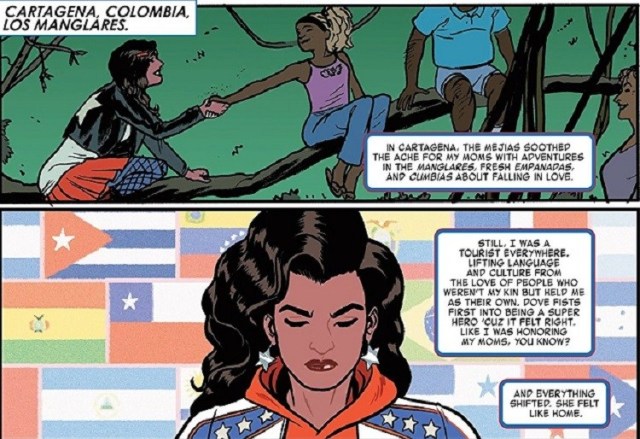 We also get to learn some about where America came from. She’s always been a Latina, but also from another planet in another dimension, and finally we learn how that works. We talk about how Latina isn’t a race, there are Black Latinas and white Latinas and Indigenous Latinas and Asian Latinas. We’re all united by culture. When America came to our world, she found the people who looked like her, Puerto Ricans in the Bronx and Colombians in Cartagena and she found family. Latinx families are famous for adopting every little kid into the clan that we can. The more the merrier — I mean, we need someone to eat all these tamales. Chosen family is where America has always found herself, whether it’s been with Latinx families, the Young Avengers or the Leelumultipass Phi Theta Beta sorority at her college.
We also get to learn some about where America came from. She’s always been a Latina, but also from another planet in another dimension, and finally we learn how that works. We talk about how Latina isn’t a race, there are Black Latinas and white Latinas and Indigenous Latinas and Asian Latinas. We’re all united by culture. When America came to our world, she found the people who looked like her, Puerto Ricans in the Bronx and Colombians in Cartagena and she found family. Latinx families are famous for adopting every little kid into the clan that we can. The more the merrier — I mean, we need someone to eat all these tamales. Chosen family is where America has always found herself, whether it’s been with Latinx families, the Young Avengers or the Leelumultipass Phi Theta Beta sorority at her college.
Finally having a Latina writer and Latino artist on the book makes so much of a difference; Gabby Rivera is able to write her in ways that other writers never have been able to. And Quinones is amazing at drawing women of all types and draws curves on women like no other man can. I’ll always love the Gillen/McKelvie/Wilson America, and their version of America will always hold a special place in queer comics history. So will Gabby Rivera’s. This was a comic about a Latina lesbian written by a Latina lesbian. That’s historic. That’s the revolution we’ve been talking about. Readers want to be able to see great Latinx superheroes, but when we also get to see real life Latinas getting jobs and writing our own stories, that makes a huge difference too. This book shows that we can be superheroes, but we can also be writers and artists and whatever we want. America Vol 1: The Life and Times of America Chavez is a great second chapter in this iconic character’s story. It’s really a shame that the book got cancelled at the end of this last year. Hopefully if more people buy this trade, Marvel will realize what a gem they had on their hands.
New Releases (January 10)
Batgirl and the Birds of Prey #18
Jem & The Holograms Infinite TP
The Wicked + The Divine Vol 6 Imperial Phase Part 2 TP
Phoenix Resurrection Return of Jean Grey #3
She-Hulk Vol 2 TP Let Them Eat Cake
Alters #9
Welcome to Drawn to Comics! From diary comics to superheroes, from webcomics to graphic novels – this is where we’ll be taking a look at comics by, featuring and for queer ladies. So whether you love to look at detailed personal accounts of other people’s lives, explore new and creative worlds, or you just love to see hot ladies in spandex, we’ve got something for you.
If you have a comic that you’d like to see me review, you can email me at mey [at] autostraddle [dot] com.
The 12 Best Lesbian, Bisexual and Trans Latinx Pop Culture Moments of 2017
If you’re a queer Latinx, it can be hard to see yourself in pop culture. American media rarely focuses on Latinx characters and stories at all, and it’s even more rare when those characters are LGBTQ. This year, we finally got some stories and characters that showed real Latina heart. Whether you’re Mexican, Puerto Rican, Costa Rican, Cuban, Panamanian or Argentinian, there were great examples of queer Latinidad for you. We’re still working on making things better, especially when it comes to real life issues about immigration and health care and education and racism, but these were some of the highlights of the year in Latinx pop culture.
1. America Chavez Gets a Comic Book and Gabby Rivera Writes it
While we recently got some bad news that this series is being canceled, it was still an amazing thing to see. Queer Latina, and former Autostraddle writer, Gabby Rivera got to write a comic about a lesbian Latina superhero. That’s something that’s never happened before. Not only did Latinx readers get to see a great role model in the Marvel’s first lesbian Latina superhero, but it was written by a real life Latinx role model too. And Rivera brought a great reality and genuine familiarity to the character that had been lacking before.
2. Becky G Plays a Queer Superhero in Power Rangers
There was a Power Rangers movie this summer, and honestly, it was my favorite superhero movie this year, even more than Thor: Ragnorok or Wonder Woman. Yeah, you heard that right. It was weird and hilarious and fun and the cast was so diverse! That diverse cast included Mexican-American singer and actress Becky G playing Trini, the yellow ranger, who is revealed to be queer in a team bonding scene.
3. Tessa Thompson Plays a Bisexual Valkyrie in Thor Ragnarok
Power Rangers wasn’t the only superhero movie this year to feature a queer woman. Afro-Latina actress Tessa Thompson confirmed on twitter that her character in the Marvel sequel Thor Ragnarok, Valkyrie, was bisexual in the movie, just like she is in the comics. There was a scene in the movie that confirmed this, but it was sadly cut.
4. Leiomy Maldonado Stars In Her Own Nike Commercial
Leiomy Maldonado is a trans Latina and one of the most iconic and legendary vogue dancers alive. This year, Nike featured her and other dancers in a commercial for their #betrue collection for Pride. This commercial made me cry like a baby.
5. Selena Gomez Has a Crush on Herself in “Bad Liar”
Selena sampled the Talking Heads and made this summer jam with one of the weirdest, gayest music videos ever. Selena plays a high school student, the female gym teacher she has a crush on, her dad (who’s trying to sleep with the gym teacher) and her mom (who’s had enough of her dad’s bullshit). As I said in slack when Autostraddle fist found out about this video, “THIS IS MY FAV VIDEO EVER?????? This video is my entire life. Selena is me, I am Selena.”
6. One Day At a Time Shows a Supportive Latina Family and a Gay Quinceañera
Netflix’s reboot of One Day at a Time, this time with a Cuban family, was one of the best shows I’ve seen all year. It only got better when Elena, the teenage daughter on the show, had a season-long coming out arc that felt real and familiar and fresh. All of this culminated with her mom, grandma and brother supporting her as she wore a white suit to her quinceañera, showing that you can honor your culture and yourself at the same time.
7. Lauren Jauregui Joins Halsey for Bi Anthem “Strangers”
Lauren Jauregui is a Cuban-American singer and member of the band Fifth Harmony. She’s also bisexual, just like Halsey, who she teamed up with on this hit song. The two sing a love song about each other, wishing for more intimacy than they can get from each other.
8. Brooklyn 99‘s Rosa Diaz is Bi
Last year, actress Stephanie Beatriz came out as bisexual, and this year her character on Brooklyn 99 did the same thing. Her coming out was sweet, real and funny. The show didn’t shy away from showing that coming out doesn’t always go smooth, and it definitely didn’t shy away from saying the words “bisexual” and “bi” as many times as they could.
9. Demi Lovato Talks About Dating Women in Her Documentary
Demi had talked about how she wasn’t straight before, but she talked about her queerness and relationships with women more than ever before in her Youtube documentary “Simply Complicated.” While most of the focus was on her struggles with mental health and addiction, she also talked about using dating apps and dating both men and women, making her one of the highest profile queer pop stars in America.
10. Frida Kahlo Makes Art in Coco
I wrote about how I had never seen myself in a movie before like I saw myself in Coco. In my review I mentioned that queer Mexican painter Frida Kahlo makes an appearance, but I didn’t talk very much about her. She shows up in the land of the dead and helps out Hector and Miguel several times in their journey through the afterlife. She’s familiar, she’s funny and she’s terrific.
11. Iconic Costa Rican/Mexican Lesbian Singer Chavela Vargas Gets Her Own Documentary
Chavela Vargas is one of my favorite Latina singers of all time. When I picked my name, I chose her first name for my middle name. This year she got a much-deserved documentary, CHAVELA, and a new generation of audiences was introduced to her. If you want to learn more about this gender non-conforming, radical, amazingly talented singer, this is a great place to start.
12. Bisexual Actress Sara Ramirez Plays Butch Bombshell on Madam Secretary
Sara Ramirez has been playing iconic bisexual character Dr. Callie Torres in Grey’s Anatomy for years, and now she plays butch bombshell Kat Sandoval on Madam Secretary. The initial pictures of her character took all of our breaths away and we didn’t recover for two full weeks. Honestly, a lot of us are still trying to recover.
Gabby Rivera on Bringing Her Queer Brown Weirdo Self to Marvel’s America

by rory midhani
Sorry this Drawn to Comics is so late you guys!!! But I have an interview with America writer Gabby Rivera, so hopefully that will make up for it!
If you haven’t read America #1 yet, put down you computer and go buy it. Or read this interview and fall even more in love with the idea of a comic about a superpowered Latina lesbian with thick thighs that’s written by a super awesome Latina lesbian with thick thighs. This first issue is so great, you guys. America decides she’s had enough of the superhero life, and so she’s going to college, and her college is called Sotomayor University, you guys, as in Sonia, the Supreme Court Justice. She’s taking classes like “Intergalactic Revolutionaries & You” and meeting awesome sororities filled with brown and Black nerds and hanging out with other queer poc. It’s EVERYTHING. Y’all, this comic is so explicitly queer, and it’s so explicitly brown, and it just makes those things normal — it’s not treating them like they’re “other,” they’re just how things are because the main character is a Latina lesbian, and so that’s what her world is like. Plus, Joe Quinones is killing it on the art, with Joe and Paolo Rivera inking, Jose Villarrubia doing colors and Travis Lanham doing letters. This book looks AMAZING. I love it so much, you guys. And here’s an interview with Gabby, so you can learn why you’ll love it too!
Mey: How does it feel to be a queer Latina writing a comic about a queer Latina superhero? You’re the first person who can say that they’ve done that, that’s awesome!
Gabby: First, right now I’m listening to ANTI and I feel like that’s really important for folks reading this interview to know. Important music things are happening, Mey.
It’s dope as hell to be the first queer Latina (maybe even first Latina ever) writer at Marvel and I’m writing the solo series for this megababe, Latina lesbian, in ripped jeans and bamboo earrings. America’s time is right now. I need to believe in the impossible, the worlds and existences never thought possible. America is living that in this series. I’m just honored to be along for the ride, you know?
M: We see America meet some new people in this first issue, like her new professor, as well as some people from her life before, like Prodigy. How many other new and old faces will we see in this series?
G: One of the best parts about writing AMERICA was that there weren’t any limits to the characters we could create and the ones we could pull in from the Marvel Universe. Making sure that America wasn’t the only brown babe in this series was important to me. And by babe, I mean ass-kicking, brilliant as hell, free and confident person/being.
She’s going to be on the quest for her people, her roots, and the true depths of her powers. Maybe she even comes across people who knew her moms. On top of that, there’s so much knowledge and wild-ass power held by the female superheroes of Marvel and America’s going to get to connect to all of it. Be on the lookout for tough, ready to rumble women of color, and some of the our favorite high-profile superheroes that you know and love from Marvel. Maybe even some X-Men if you’re lucky…
M: I’m absolutely in love with this university that you’ve created. How important was it to you to put America in a place where she’s surrounded by other poc and learning about poc in an environment like this?
G: Yo, it’s fun, right? I wanted to explore the university of my dreams. America gets to study and learn in a place where anything is possible.
I’ve had two Puerto Rican teachers in my life: my mom in kindergarten and my college freshman Spanish class teacher. Meeting her was like magic; she knew my whole life kinda. She knew I failed my Spanish entrance exam because I didn’t care and because even though I knew the tense, no one in my house called it the “imperfect progressive.” She knew I called bus “guaga” and not “autobus.” America deserves that type of connection as her starting off point.
She deserves an entry point so normal that it doesn’t even register as remarkable. S.U. just exists without anyone perplexed as to how or why. And that’s what America’s getting.
M: What of yourself are you bringing to this comic? You’ve never written comics before, so I’m excited to see what you do with a character like this that people know and love!
G: I’m a queer brown weirdo and I love every short inch of myself. I’m bringing all that round, brown, goodness to this story. All the things that make me laugh and make me feel strong, they’re going to be in America’s world.
But really, it’s about America. It’s about this character who’s been on the Marvel come up for almost six years. She’s played the vibrant, hella powerful, tough girl to different teams of folks, shining in every moment she gets. And now, now she gets her own moment. I am honored to get to write her.
 M: Are we gonna see America get a new girlfriend?
M: Are we gonna see America get a new girlfriend?
G: What makes you think she needs a new girlfriend? Maybe America just wants to punch star-shaped holes into other dimensions while looking fierce af and living her best life.
I love you, Mey!
Welcome to Drawn to Comics! From diary comics to superheroes, from webcomics to graphic novels – this is where we’ll be taking a look at comics by, featuring and for queer ladies. So whether you love to look at detailed personal accounts of other people’s lives, explore new and creative worlds, or you just love to see hot ladies in spandex, we’ve got something for you.
If you have a comic that you’d like to see me review, you can email me at mey [at] autostraddle [dot] com.
America Chavez Gives Me Hope For Queers of Color Everywhere
“Did you see this?” a friend said, pulling my attention from the television screen and onto the iPhone she held up to my face. It was Saturday — just over one week after inauguration — and I was listening in disbelief as a pair of news anchors struggled to make sense of Trump’s new Muslim ban, the latest in a string of controversial actions the reality TV star had taken in his first few days as president.
I took my friends phone, scrolling through illustrations of a curvy, dark-haired woman in a blue starred T-shirt. I quickly learned that the woman in the pictures was America Chavez, Marvel’s new, queer Latina superhero.
Over the past several months, I have watched my surroundings transform into some sort of fictional dystopia. Despite this, seeing illustrations of America Chavez have filled me with hope.
As a Latina kid growing up in a primarily white community in the Pacific Northwest, I was always desperate to fit in. But without friends or role models that shared my mixed, diasporic heritage, my childhood was isolating. I remember watching the other kids at my Catholic elementary school devour comic books they saw themselves reflected in. But I never had much of a reason to open one up; inside, I only found further proof of my incongruity.
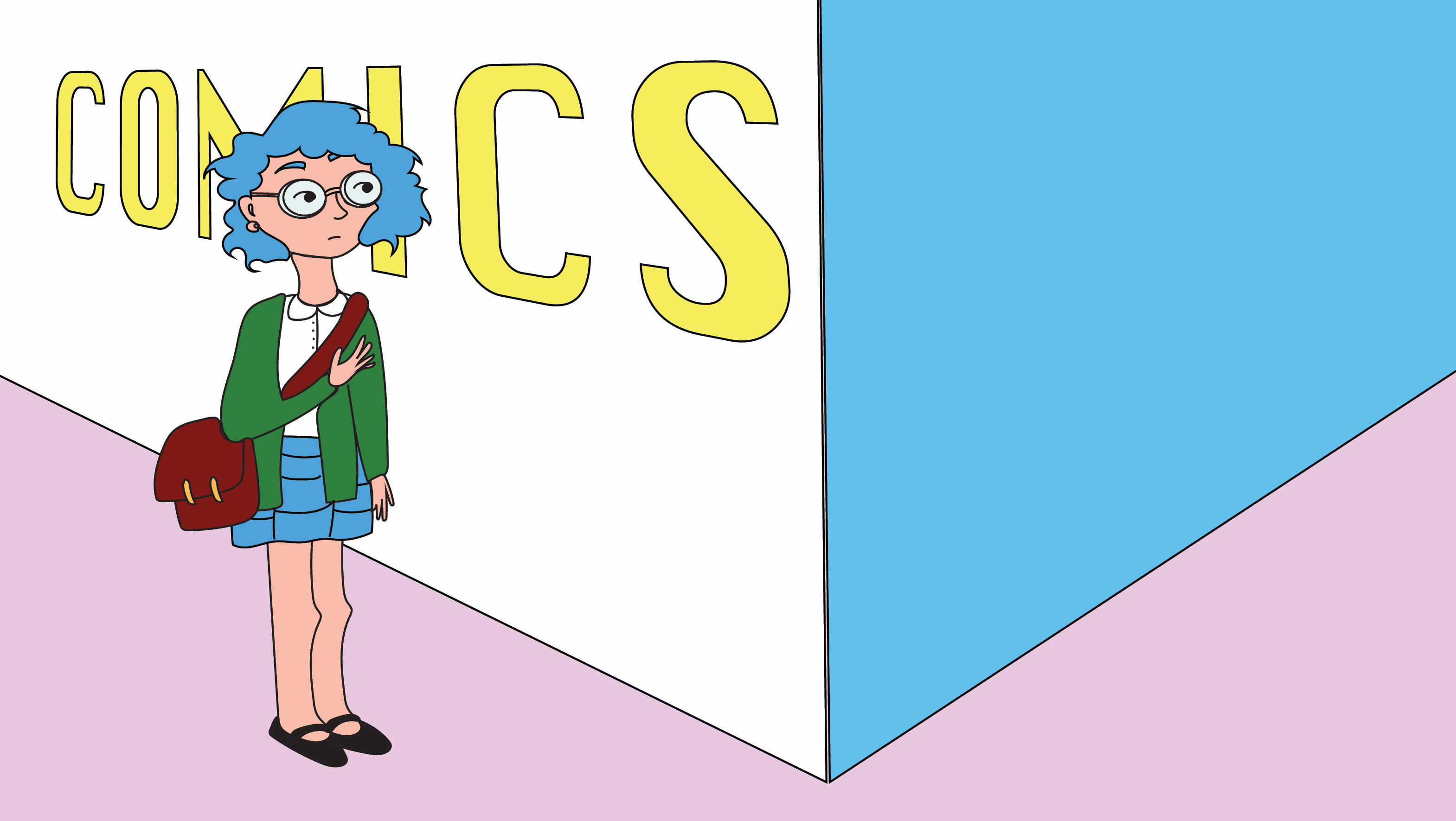
Illustration by Ludmila Leiva
Lately, I am often reminded of this feeling whenever I consume the seemingly-endless stream of politically-charged news headlines. Each one, it seems, tells of a new, dire threat to many of this nation’s communities — from African Americans and Muslims to immigrants and LGBTQ+ individuals. Like many who have multiple intersecting identities, I am member of more than one of these groups.
Being a marginalized person has never been easy. But in times of intense sociopolitical upheaval — such as we find ourselves in today — many of us are especially, and disproportionately, affected. Still, difficult times throughout history have often given rise to unique manifestations of endurance and resistance. Today, I see no better example of this than America Chavez.
Chavez, who Boricua writer Gabby Rivera defines as a “foxy, badass, hard femme Latina,” was originally introduced to the world in a 2011 miniseries called Vengeance. After receiving a lot of attention, she was revived in a 2013 reboot of the Young Avengers. Starting today, she is once again being brought to life as the main heroine in a new Marvel comic.
Comics and other forms of critical art and commentary have long been used as tools for social resistance. All around the world, comics and cartoons have been and continue to be used as vehicles for political commentary — from Argentina’s Mafalda who provided nuanced social commentary during one of the most tumultuous times in Argentina’s history to Persepolis’ reflection on Iran following the Islamic revolution. Here in the United States, companies such as Marvel have long used the comic industry as a platform for social and political commentary.
Recently, we have seen Marvel, in particular, prioritize the inclusion of more diverse characters, such as Muslim character Kamala Khan and the queer black characters in Roxane Gay’s “World of Wakanda.” To me, the increased incorporation of queer and non-white characters in mainstream cartoons and comics marks a new and necessary paradigm of critical commentary.
Our current sociopolitical climate has taken a toll on large swaths of this nation. However, it is crucial that we acknowledge the unique impact current events have had — and continue to have — on marginalized folks. Though many marginalized individuals have long felt like we are not a priority, today’s administration has made it abundantly clear that this is, in fact, the case.
Often, being a marginalized American means feeling like an afterthought. Whether we look at this country’s prisons, which teem with brown and black bodies, the millions of hardworking immigrants who are constantly written off as dangerous criminals, or the many LGBTQ+ individuals who are routinely denied basic rights just because of who they love, it is difficult to deny that, for many of us, a Trump presidency is much more than just a four-year inconvenience.
But, as many of us struggle to find our footing in a country that repeatedly treats us like second class citizens, characters like Chavez provide a glimpse of hope in the face of darkness. When I look at her toothy, defiant smile, I see the persevering face of brown, queer America.
I grew up accepting that I would never see myself or my reality reflected in mainstream comics. But today, in a time where many marginalized individuals are constantly robbed of our agency and power, fictional characters like America Chavez are challenging these assumptions. My only hope is that Chavez and others like her will one day be the norm, not mere exceptions.
I still struggle every day to find and remember my strength in the face of adversity. In all likelihood, having marginalized identities will continue to be a challenge, long beyond just the next four or eight years. Even so, when I think of America Chavez — her curvy figure, bushy brown hair, and unapologetic queerness — I can’t help but smile.
It may sound quixotic, but often just knowing Chavez exists helps me stand a little taller and feel a little bit stronger. And while I don’t know if comics alone will have the power to entirely transform our society’s status quo, to me Chavez is indisputable evidence of a brighter future. And, on most days, a little bit of proof is all I need.
Gabby Rivera Will Write “America,” Marvel’s New Queer Latina Comic Book, And We’re Flipping Out
The world is dark and light is precious and here’s a display of fireworks: Gabby Rivera is writing America Chavez’s new solo comic book! Marvel announced their plans to give our favorite queer Latina teen her own title just last month at New York Comic Con, but we had no idea they’d bring on a queer Latina to write her; much less one of our all-time favorite queer Latina writers. (And Sara Ramirez’s too, while we’re on the subject.) Gabby, as you know, is the author of Juliet Takes a Breath and a longtime contributor to Autostraddle and the former head of our QTPOC Speakeasy. She’s now the Youth Program Manager at GLSEN.

Variant Cover of America #1. Art by Marguerite Sauvage.
Refinery29 posted the America Chavez creative team announcement today, along with an interview with Gabby and a first look at the art for the new book. We also got a little information about which Marvel universe America will be inhabiting; she’s been in practically all of them! And we got a little information about how our Trans Editor and Drawn to Comics expert Mey Rude consulted with Gabby on the book. (I buried that lede because I wanted to stretch out the excitement.)
From Refinery29:
What were some of the things that excited fans about America?
Gabby Rivera: “One is, the identities: Queer Latina. She’s also a positive presence and has these catch phrases, like ‘chico.’ And she has feelings for Kate [Bishop, a.k.a. Hawkeye]. But there are more questions about what her powers are, who she is and what is she interested in. My friend Mey was like Gabby, ‘Don’t try to write a superhero comic book. That’s not why they reached out to you. Put all the joy and excitement and energy and quirkiness that you did with Juliet and bring it to America.’ So what song does she listen to when she wakes up in the morning? Does she brush her teeth in her underwear? What type of girl is she? The fundamental questions you have about someone you want to be friends with.”
One of the most frustrating things about women on superhero teams — in both comic books and movies — is that their actions are almost always overshadowed by the men on the team and their motivations are rarely explored. Think about Avengers: Age of Ultron. Black Widow, as written by the guy who gave us Buffy, was reduced to a woman who couldn’t have children. That’s was it. That was her main thing. The huge backstory reveal feminist fans had been promised for years after watching women in Marvel’s cinematic universe get ignored and tossed aside was that Natasha Romanov’s major life milestone was a decision to become an assassin instead of a mother. It was the one thing that defined her entire personality.
Well, not in this new Marvel book! Gabby says she’s excited to explore America’s agency and her story outside the teams she’s been a part of: “So my thinking for this new book is that she’s finally asking herself that question: What’s in it for me? Why am I fighting with these people? What I want is to go to college and I want to start over, and I want to learn about myself and do this for myself.”
I can’t wait to watch her answer all those questions.
America Issue #1 will arrive in March 2017. I’ll bet Mey and Gabby will have a conversation about it on this very website as the drop date gets closer!
